No CrossRef data available.
Article contents
Midrash in Parables
Published online by Cambridge University Press: 15 October 2009
Abstract

- Type
- Review Essay
- Information
- Copyright
- Copyright © Association for Jewish Studies 1995
References
1. I am distinguishing here between literary criticism of midrash and an engagement with midrash that is theoretically and hermeneutically motivated, such as my own work as well as that of others.
2. I think that Stem is absolutely correct in identifying the motives of those who deny the allegoricity of parables in “a yearning for Absolute Presence…for the parable as Logos” (p.12), but I would argue that it is this same yearning which also produced and privileged allegory in Western literature from Philo to Bunyan. My forthcoming paper in Paragraph, “Allegoresis Against Difference; or, the Metalinguistic Origins of the Universal Subject,” will set out this notion somewhat more fully.
3. Sanders, E.P., Paul and Palestinian Judaism: A Comparison of Patterns of Religion(Philadelphia, 1977), p.24.Google Scholar
4. As Stern properly notes, the term nimshal itself never occurs in rabbinic literature and only appears in medieval Hebrew (p. 13).
5. Remember, once more, that Stern agrees that the very separation of the exegetical mashal form into two separate units is an artifact of later provenance. Stern also argues that “the nimshal has priority, chronologically as well as ontologically, over the mashal-proper,” meaning, however, something quite different by this.
6. This does not exclude the possibility of later, near-mechanical production of pseudoexegetical meshalim in imitation of the prestigious form. The example discussed by Stern on pp. 174–175 seems to me to be just such a case. It may be that like the Indian blind men describing the elephant, Stern's mashal fits better his late midrashic texts, while mine is a more appropriate description of the early texts that I deal with in my book. This is not, however, the whole story, as I shall try to demonstrate in the next section.
7. For an excellent description of the theory of gaps, see Stern, pp. 74–75.
8. I think that this aspect of analysis was missing in my own book on midrash, in which I was wholly engaged in the first step. Fraade's, StevenFrom Tradition to Commentary: Torah and Its Interpretation in the Midrash Sifre to Deuteronomy (Albany. N.Y., 1991) seems to me to go a long way to achieving balance between these two elements.Google Scholar
9. I am not claiming that Stern never does this, but often enough he will cite a mashalwithout even giving us the biblical context within which it appears, foreclosing totally the possibility of reading the mashal as an interpretation of that context.
10. Obviously Stern would not agree with this judgment, thus proving once more the old nostrum that what I say is the ![]() , what you say is
, what you say is ![]() .
.




